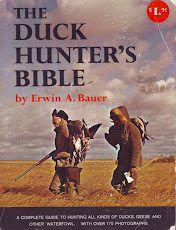
99% percent of my hunting takes place on the Atlantic Ocean with the majority of ducks being the American common eider, Northern common eider, surf scoter, black scoter, white-wing scoter, old squaw (long-tailed duck), bufflehead, black duck, golden eye, and an occasional mallard or goose.
The biggest challenge when hunting the Bay of Fundy in Maine is working with the tide, wind and temperature (not necessarily in any particular order). I've spent my entire life thinking and practicing strategies to best enhance the hunt and the above three variables become the pillars of success or failure. My blog entry “Working a Different Wind” is a fair assessment of how I anticipate the above listed variables.
http://thedowneastduckhunter.blogspot.com/2008/12/working-different-wind.html
Due to the nature of our tides, I use long lines of eider, scoter, and old squaws decoys attached to twenty-five pound mushrooms anchors. Typically, I run about 40 eiders, either on two separate lines or tied all together. Depending on the wind direction and tide, I may choose to let the line run on one anchor. Usually, I put one anchor on each end to assert the position of the deeks. For areas such as marshes, mud flats, or shorelines, I do use long lines for the black ducks, and also use individual anchors for some to give a more realistic presentation. I suppose that leads one to believe that some birds are a little more sharp than others. For me, one black duck is a more difficult duck to chase than one hundred eiders.

I do have shadow decoys (silhouette), but don't use them very often. Most of my gunning is over plastic decoys, but my father and I have on occasion used our own that we made during the off season.
In terms of my water fowling transportation, I hunt out of a variety of boats. Since I'm a lobsterman as well, most of my tending craft can also double as hunting vessels. All are painted in a camouflage pattern and are very reliable. If they are good enough for lobstering, worming, clamming and other work, then they are certainly dependable for duck hunting.

I have an 18 foot Lund Alaskan with a 40 horsepower Mercury. The motor was originally on my 16 foot aluminum, but my father and I found the Alaskan with a 25 horsepower Honda tiller. By swapping motors, we now have two very reliable watercraft. However, the 16 footer has been in moth ball so I recently picked up a Northern Flight boat blind in marsh grass for a little freshwater hunting.
In addition, I have several smaller tenders for those hunts that do not require one of the aluminum boats. They range from eight to twelve feet and are great for negotiating difficult areas. We typically use these around mussel beds and ledges in shallow water. For these boats, I have a 3.3 horsepower Mercury or the ever
 dependable oars.
dependable oars.I'm currently dying for the new Old Town Canoe Ambush model. It's a canoe/kayak hybrid with an 800 pound carrying capacity. If I can force myself to buy it I will, but it's hard to justify that purchase when I don't really need it.
What was the defining moment that cemented your passion for hunting and who was it that passed this tradition on to you and how has this impacted your life?
When you are the son of a local duck hunting legend, it's hard to not become the next generation. My father who has his own chapter in Ron Koch's “All Duck Hunters are Crazy” has spent his entire life hunting. When people come to our area and ask for old time duck hunters, he gets the referral. He laughs when he's thrown into the old timer category, but he also understands that his breed of hunter is a thing of the past. To better explain the previous statement, he lived in a time and place where ducks were a staple. There existed no bad shots, some hunters wouldn't shoot unless they knew they could get two in one shot. He used to sit in school as a youngster and listen to the hunters during the fall. With the number of hunters and how close the school was to the ocean, it's no wonder why he says he struggled in school.
I shot my first rabbit when I was five years old, it was with a 16 gauge Ithaca pump and I remember pointing at the white spot in the woods while my dad braced the shotgun. One shot later, and I was heading home to show my mother what her son had done. That was an important day.
However, the day that changed my standing as a passionate hunter was November 2, 1993. I had been skipping open gym basketball practice to go deer hunting and since I had been on the varsity squad the previous three years, getting in trouble wasn't going to happen.
I took my first duck at age 11. A white-wing scoter cupped towards the decoys and I dropped it with my new Remington 870 Express. Having my father be so proud of me just made me want to keep doing well. He's my biggest fan and best mentor, although I've taken my craft to a different level with technology, education, and research, I still bounce every idea of off him.

On a side note, my duck hunting has been greatly enhanced by reconnecting with an old friend, the Rabid Outdoorsman, and his younger brother who is frequently on my blog. Since then, we have formed a duck hunting club that never has a dull moment. I discussed the story in
“Duckpower- God love it!!!” http://thedowneastduckhunter.blogspot.com/2008/05/duckpower-god-love-it_23.html
That concludes part 1 of my interview with Tony, The Downeast Duck Hunter. Look for part 2 later this week. In the meanwhile go check out his blog and the wonderful videos.
Women's Hunting Journal Integrity For The Hunt








4 comments:
great interview, looking forward to the rest of it.
Thanks Editor, appreciate it. Part two is coming in a couple days. Thanks for stopping by!
Interesting interview. Well done.
I'm trying to figure out if the picture in his boat are decoys or he's feeding real ones? :)
Hunter's Wife, actually those are decoys that he and his dad made and that is his dad setting the decoys out.
Post a Comment